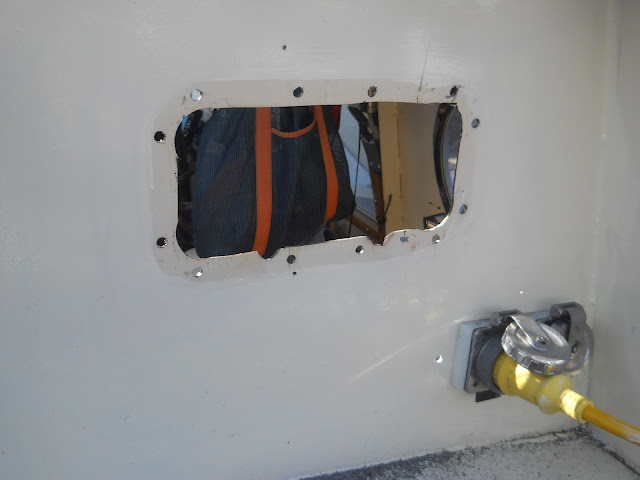 |
| Fixed plasticky fixed portlight: Not wanted on the voyage |
I came to agree with this sentiment. After all, at sea, the "cat flap" will be down in fair weather, even boisterous fair weather, and plenty of air will come in. So the new hatch is flat and fearsome and hard to dent. Then, as my last post indicated, we tidied up the AC power inlets and did a spot of painting. All this made the 5 x 12 inch plastic fixed Beckson-type portlight, which came with the boat and merely shed a bit of light down the aft cabin companionway, look a little sad.
After some thought, I decided to replace it with an opening portlight, both for ventilation and for communication with the afterdeck should the main companionway be closed off. Ventilation, even once the pilothouse roof insulation is restored, is a big deal on a steel boat and will be even more so in the tropics. I had had a good experience (and indeed, am still having it) with Newfound Metals' line of reasonably priced and sturdily built products, and the circular portlights put in during 2011 are still looking great.
A call to Newfound Metals got the owner, Richard, on the phone and, as is often the case with smaller marine-trade manufacturers, I had an entertaining and insightful chat with him about his business. He recommended the self-sealing Trimatrix port and I ordered a teak spacer ring (as the metal sides of the pilothouse are thinner than the typical fibreglass boat's cabin house, plus a chromed bug screen. They arrived from the Seattle area in about four days and cost about $180 U.S. Newfound Metals, realizing their customers have, uh, variable skill sets, provide very good online instructions and even videos, meaning only the truly ham-handed can screw things up. As for build quality, I consider Richard's firm the equivalent of Garhauer for quality and strength. From me, that's high praise.
 |
| The original 5 x 12 inch void with the 12 new and enlarged bolt holes and space for the "spigots" cut in |
When I removed the old fixed portlight, while the basic 5 x 12 hole was good (it was actually 5.5 x 12.5 inches with radiused corners), I had to carefully grind out little divots for the "spigots" that drain water from the glass of the portlight and keep it from pooling on the frame. Then I had to drill 12 (!) new holes for the carriage bolts (gasketed and mated to metal strips on the outside) to mate with the 6 mm SS bolts. Despite being told by Richard that I needn't use butyl, I did use it in thin strips to position and temporarily stick the outer ring and the inner teak spacer ring on either side of the pilothouse bulkhead.
 |
| The unboxing: I have yet to be disappointed by the quality of design, materials or execution of Newfound Metals' products. |
The drilling was two-stage, first with a 3/ 16th inch cobalt bit and secondly with a 3/8th inch titanium bit, both on my monster Makita. Knowing that this was a tough job to do solo, I waited for the next day Mrs. Alchemy was free. She painted the bare metal and drill holes and we cleaned up the debris of metal shavings and then she pressed down the outer ring from the outside and put in the first carriage bolt head. This was tricky, but once four were loosely in, things got easier. We realized a couple of my drill holes were fractionally off and would not let the bolt head nestle in their spots, so out came the Dremel with a grinding stone attachment and I can live with a couple of slightly egg-shaped bolt holes that will never again see the sun, I sincerely hope.
We are rather pleased with the results:
 |
| Light, air and bug stopping. All I ask for, really. |
 |
| Closed for business. |
 |
| Open for the airing out. |




No comments:
Post a Comment